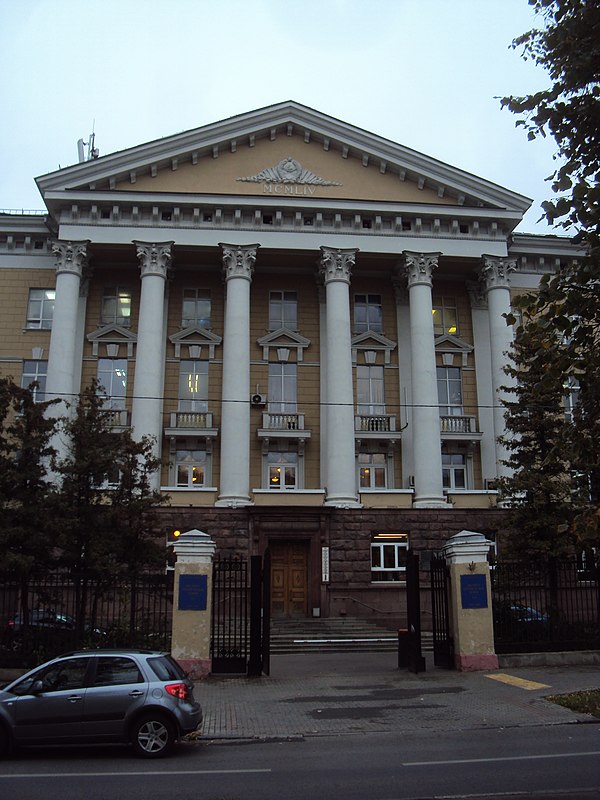Top Qs
Timeline
Chat
Perspective
N. D. Zelinsky Institute of Organic Chemistry
Research institute From Wikipedia, the free encyclopedia
Remove ads
N. D. Zelinsky Institute of Organic Chemistry (ZIOC) is one of the research institutes of the Russian Academy of Sciences in the field of chemistry. The institute employs more than 900 people in 39 research laboratories and groups. It is located in Moscow.
Remove ads
Remove ads
History
Summarize
Perspective
The institute was founded on February 23, 1934, in Moscow on the basis of the High Pressure Laboratory and the Organic Synthesis Laboratory.[1] Among the founders were academicians A. E. Favorsky, N. D. Zelinsky, V. N. Ipatiev, A. E. Chichibabin, and later N. Ya. Demyanov, M. A. Ilyinsky and others. In 1953, the institute was named after Academician N. D. Zelinsky, who headed one of the departments from 1936 to 1953. The world fame of the institute is associated with the names of many prominent scientists who worked there. Among them are academicians A. E. Favorsky, N. D. Zelinsky, A. A. Balandin, B. A. Kazansky, A. N. Nesmeyanov, I. N. Nazarov, I. L. Knunyants, A. E. Porai-Koshits, V. V. Korshak, L. F. Vereshchagin, M. M. Shemyakin, M. I. Kabachnik, H. M. Minachev.
During the Great Patriotic War, carbinol glue (Nazarov glue) was developed for repairing military equipment in the field.[2]
Synthesis methods were developed and batches of drugs were produced, including the drug vinylin (Shostakovsky balm).[3]
Nesmeyanov Institute of Organoelement Compounds, Institute of High Pressure Physics in 1954, and Institute of natural compounds chemistry (INCC) (now Shemyakin-Ovchinnikov Institute of Bioorganic Chemistry) in 1959 are separated from N. D. Zelinsky Institute of Organic Chemistry. At the same time, the traditional areas of research at the ZIOC expanded and developed. Several other research centers were created with the support of scientists from the ZIOC. Among them are the A. E. Favorsky Irkutsk Institute of Chemistry, Institute of Bioorganic Chemistry of the National Academy of Sciences of Belarus, V. I. Nikitin Institute of chemistry and the Institute of Organic Chemistry of Turkmenistan.
The institute is located at Leninsky Prospekt, 47. The building was built in 1954 according to the design of the architect Alexey Shchusev.
Remove ads
Directors
Since the founding of the institute, it has had seven directors:
- Alexey Evgrafovich Favorsky (1934–1939)
- Alexander Nikolayevich Nesmeyanov (1939–1954)
- Boris Alexandrovich Kazansky (1954–1966)
- Nikolai Konstantinovich Kochetkov (1966–1988)
- Vladimir Aleksandrovich Tartakovsky (1988–2002)
- Mikhail Petrovich Egorov (2003–2023)
- Alexander Olegovich Terentyev (since 2024)
Main fields of research
- Physical and synthetic organic chemistry
- Organic chemistry of natural compounds
- Catalytic organic synthesis and physicochemical basis of catalysis
- Computer chemistry and modern information technologies
Discoveries and inventions
Summarize
Perspective
Remove ads
Facilities
- Fourier transform ion cyclotron resonance mass spectrometer (FT-ICR-MS) solariX XR 15T, Bruker, Germany, 2019
Publishers
- Mendeleev Communications
- "Успехи химии" (in Russian); English translation: Russian Chemical Reviews
- “Кинетика и Катализ” (in Russian); English version: Kinetics and Catalysis
- "Известия АН. Серия химическая" (in Russian); English version: Russian Chemical Bulletin
General references
- Monograph by A.M. Rubinstein "Institute of Organic Chemistry of N.D. Zelinsky" / "Nauka", 1995. (Монография А.М.Рубинштейна "Институт органической химии имени Н.Д.Зелинского" / «Наука», 1995).
References
Wikiwand - on
Seamless Wikipedia browsing. On steroids.
Remove ads

